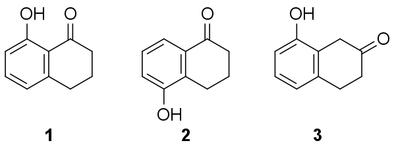I can understand in 1 the conjugate base has more stability for better resonance but in 2 and 3 the effect of resonance cannot be considered. How can we compare the inductive effect in such case?
-
1$\begingroup$ In the future, please use a competent title specific to your problem, apply proper punctuation and capitalization, name the compounds and make sure the numbering and wording you are using are traceable. $\endgroup$– andselisk ♦Commented Feb 25, 2023 at 16:38
1 Answer
Let's look at some experimental $\mathrm{p}K_\mathrm{a}$ values of known hydroxytetralones and related compounds (Ref.1):
$$ \begin{array}{l|c|c|r} \text{Entry} & \text{Compound} & \text{Ionic strength} & \mathrm{p}K_\mathrm{a} \\ \hline 1& \text{phenol} & 0 & 9.98 \\ 2& \text{phenol} & 0.100 & 9.78 \\ 3& \text{8-Hydroxy-1-tetralone} & 0 & 11.31 \\ 4& \text{8-Hydroxy-1-tetralone} & 0.100 & 11.14 \\ 5& \text{6-Hydroxy-1-tetralone} & 0 & - \\ 6& \text{6-Hydroxy-1-tetralone} & 0.100 & 7.74 \\ 7& \text{2-Hydroxyacetophenone} & 0 & 10.26 \\ 8& \text{2-Hydroxyacetophenone} & 0.100 & 10.07 \\ 9& \text{3-Hydroxyacetophenone} & 0 & 9.19\text{ (Ref.2)} \\ 10& \text{4-Hydroxyacetophenone} & 0 & 8.05\text{ (Ref.2)} \\ 11& \text{4-Hydroxyacetophenone} & 0.100 & 7.87 \\ \hline \end{array} $$
It should be noted that the properties of 8-Hydroxy-1-tetralone, which is similar to that of 2-Hydroxyacetophenone except that the carbonyl oxygens is restricted to the free rotate. In contrast, after the proton transfer, the carbonyl oxygen of the anion of 2-Hydroxyacetophenone is free to rotate away from the anionic oxygen (conjugate base of the acid). Nonetheless, in these compounds, the hydrogen of hydroxyl group may be intramolecularly hydrogen bonded to the carbonyl oxygen.
A comparison of p- (Entries 10 & 11; mesomeric) and m-substitutions (Entry 9; pure inductive) in phenol, which are included for completeness, shows the well known enhancement from mesomeric interaction of p-groups. Such effect is clearly evident in the entry 6. However, the effects important to this question is the interactions of groups ortho to each other such as those in entries 3, 4, 7, and 8. The authors of Ref.1 adequately put is as:
Organic theory is notably inadequate in the quantitative sense for correlating substituent effects and particularly so for o-substitution. which in the present study involves the formation of intramolecular hydrogen bonds.
The complexity of the problem is apparent from a consideration of $\mathrm{p}K_\mathrm{a}$ values in the above Table. Whereas p-substitutions of relavent carbonyl groups in phenol (or in the tetralone structure) increases the acidity by about $2$ $\mathrm{p}K$ units (due to mesomeric interactions), the corresponding substituénts in the o-position produce again two molecules of similar structure (entries 3, 4, 7, and 8) but with acid strengths less than that of phenol. Keep in mind that the complete theoretical treatment of the effects of substituents on the acid dissociation equilibrium will require consideration of both the acid and anion (after proton transfer). In the acid, variation in the strength of intramolecular hydrogen bonding must be a major factor in the o-carbonyl substitution.
References:
- Lawrence B. Magnusson, Clarence Postmus, Jr., and Carolyn A. Craig, "Coördination in Solutions. I. Acid Strengths of Phenol Derivatives in Water," J. Am. Chem. Soc. 1963, 85(12), 1711-1715 (ODI: https://doi.org/10.1021/ja00895a001).
- The $\mathrm{p}K_\mathrm{a}$ for 3-hydroxyacetophenone is from: F. G. Bordwell and Glenn D. Cooper, "Conjugative Effects of Methylsulfonyl and Methylthio Groupings," J. Am. Chem. Soc. 1952, 74(4), 1058–1060 (ODI: https://doi.org/10.1021/ja01124a057).

